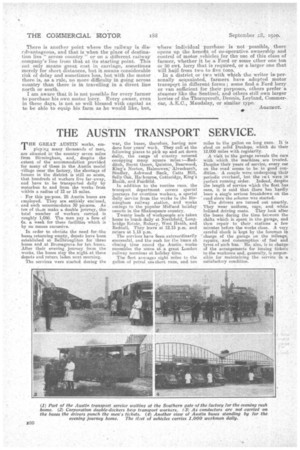THE AUSTIN TRANSPORT SERVICE.
Page 36

If you've noticed an error in this article please click here to report it so we can fix it.
Pr HE GREAT AUSTIN works, em
ploying many thousands of men, are situated. in the country seven miles from Bilmingham, and, despite the extent of the accommodation provided for many of them in the Austin model village near the factory, the shortage of houses in the district is still so acute, that hundreds of workers live far-away, and have to be transported daily by motorbus to and from the works. from within a radius of 12 or 15 miles.
For this purpose, 25. Austin buses are employed. They are entifely enclosed, and each accommodates 50 persons. As ten of them make a double journey, the total number of workers carried is roughly 1,050. The men pay a fare of 6s. a week for these facilities which is by no means excessive.
In order to obviate the need for,the buses returning empty, depots have been established at Bellbroughthn for three buses and at Brom.sgrove.for ten buses. After their evening journey fr.cm the works, the buses stay the night at these depots and return laden next morning.
The services were started during the
war, the buses, therefore, having now done four years' work. They call at the following places to pick tsp and set down daily, the range of country covered occupying many square 'miles :—Redditch, Burnt. Green Quinton, Bearvvood, King's Norton, Fllesowen; Alvechurch, Studley Ashwood Bank, Catts Hill, Belly Oa, Halbourne, Cotteridge, King's Heath, and Fairfield.
In addition to the routine runs, the transport department covers special journeys for overtime workers, a special daily service from the wcrks to the Birmingham railway station, and works outings to the ipopular Midland holiday iesorts in the Shakespeare country.
. Twenty loads of workpeople are taken home to lunch daily at Northfield,'Lengbridge Estate, Ruhery, West Heath, and Rednall. They leave at 12.15 p.m. and return at 1.15 p.m. The services have been extraordinarily successful, and the rush for the buses at closing time round the Austin, works resembles the scene at a great London railway terminus at holiday thee.
The fleet averages eight miles to the gallon of petrol orisshort, runs, and ten
miles to the gallon on long runs. It is shod on solid Dunlops, which do their 12,000 miles with regularity.
A visit to the garage reveals the care with which the machines are treated. Despite their years of service, every oar on the road seems to be in good condition. A couple were undergoing their periodic overhaul, but the reA were in perfect running order. Indeed, despite the length of service which the fleet has seen, it is said that there has hardly been a single serious breakdown on the -road since the scheme was started..
The drivers are turned out smartly. They wear uniform, caps, and white holland driving coats. They look after the buses during the time between the shifts which is spent iii the garage, and then repair to their stations a few minutes before the works close.. A very careful check is kept by the foreman in. charge of the garage on the Mileage, repairs, and consumption of fuel and tyres of each bus. He, also, is in charge of the arrangements for issuing tickets to the workmen and, generally, is responsible for maintaining the service in a satisfactory condition.






































